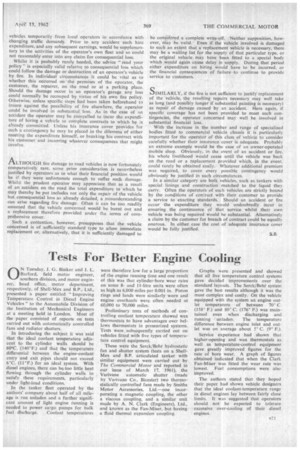Tests For Better Engine Cooling
Page 79

If you've noticed an error in this article please click here to report it so we can fix it.
ON Tuesday, J. G. Bisiker and J. L. Barford, field motor engineer, southern division, and motor engineer, head office, motor department, respectively, of Shell-Mex and I3.P., Ltd., presented a paper entitled "Improving Temperature Control in Diesel Engine Vehicles" to the Automobile Division of the Institution of Mechanical Engineers at a meeting held in London. Most of the paper consisted of reports on tests carried out with automatically controlled fans and radiator shutters.
In introducing the subject it was said that the ideal coolant temperature adjacent to the cylinder walls should be 60°C. (140°F.) and that the temperature differential between the engine-coolant entry and exit pipes should not exceed 6°C. (11°F.) for an ideal system. With diesel engines, there can beitoo little heat flowing through the cylinder walls to satisfy these requirements, particularly under light-load conditions.
In the tanker fleet operated by the authors' company about half of all mile, age is run unladen and a further significant amount of light engine running is needed to power cargo pumps for bulk
fuel discharge. Coolant temperatures
were therefore low for a large proportion of the engine running time and one result of this was that cylinder-bore wear rates on some 8and 11-litre units were often as high as 6,000 miles per 0.001 in. Piston rings and lands were similarly worn and engine overhauls were often needed at 60,000 to 70,000 miles.
Preliminary tests of methods of controlling coolant temperature showed wax thermostats to have advantages over bellows thermostats in pressurized systems. Tests were subsequently carried out on vehicles fitted with five types of temperature control equipment.
These were the Serek/Behr hydrostatic fan and shutter system (tests on a ShellMex and B.P. articulated tanker with similar equipment were carried out by The Commercial Motor and reported in our issue of March 17, 1961), the Varivane automatic shutter (made by Varivane Co., Bicester) two thermostatically controlled fans made by Smiths Motor Accessories, Ltd.—one incorporating a magnetic coupling, the other a viscous coupling, and a similar unit made by A. N. Clark (Engineers), Ltd., and known as the Fan-Miser, but having a fluid thermal expansion coupling.
Graphs were presented and showed that all five temperature control systems gave decided improvements over the standard layouts. The Serck/Behr system gave the best results although it was the most complex and costly. On the vehicle equipped with the system an engine outlet temperature of between 70° C. (158° F.) and 80' C. (176° F.) was maintained even when discharging and running unladen. The temperature difference between engine inlet and outlet was on average about 5° C. (9° F.).
Service experience had shown that higher-opening and wax thermostats as well as temperature-control equipment gave greatly improved figures for the rate of bore wear. A graph of figures obtained indicated that when the Clark Fan-Miser was fitted the wear rate was lowest, Fuel consumptions were also improved.
The authors stated that they hoped their paper had shown vehicle designers that the ideal coolant-temperature range in diesel engines lay between fairly close limits. It was suggested that operators should not be expected to tolerate excessive over-cooling of their diesel engines.




















































































































